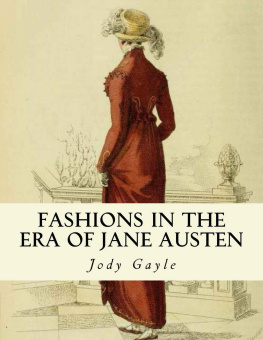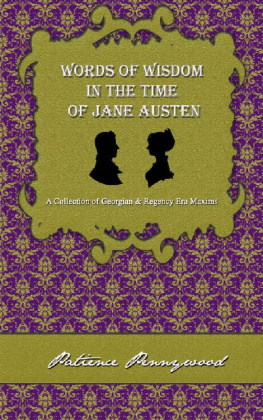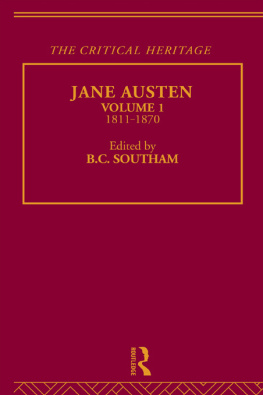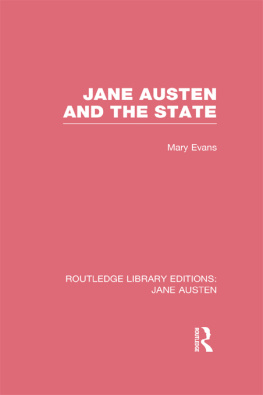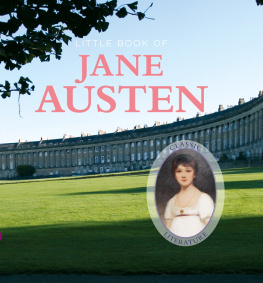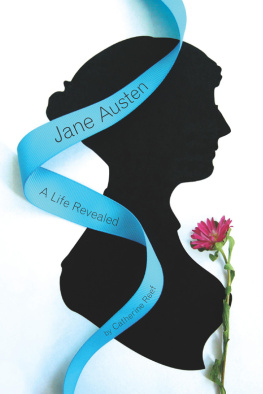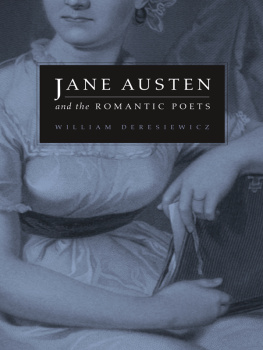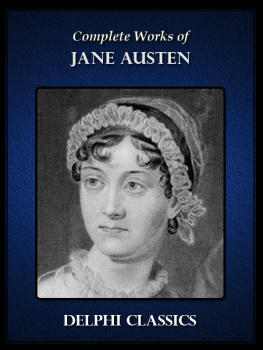Fashions in the Era of Jane Austen
Ackermann's Repository
OF
ARTS, LITERATURE, COMMERCE,
Manufactures, Fashions, and Politics
Designed and Edited by
Jody Gayle
Copyright 2012, Jody Gayle
Publications of the Past, Inc.
Post Office Box 3087
Columbia, MO 65205
All rights in this book are reserved. No part of this work may be used or reproduced inany manner whatsoever or transmitted in any form or by any means, electronic or mechanical,including photocopy, recording, or any information storage and retrieval system,without written permission from the copyright owner except in the case of brief quotationsembodied in critical articles and reviews.
The scanning, uploading, and distribution of this book via the internet or any other means without the permission of the author is illegal.
Please purchase only authorized electronic editions, and do not participate in or encourage electronic piracy of copyrighted materials. Your support of the author's rights is appreciated.
For further information email
or vist
JodyGayle.com
E-Book Edition October 2012 ISBN: 978-0-9884001-0-8
PDF e-book ISBN: 978-0-9884001-1-5
Cover: Morning Dress from Ackermann's Repository of Arts, December 1813
Table of Contents
Acknowledgements
My sincerest gratitude to the Philadelphia Museum of Art Library for the permission to reintroduce the 200 year old Ackermann's Repository of Arts to a whole new group of readers.
A special thank you to the authors of Regency fiction and for writing about that fascinating character, the ton. This book was inspired from the work of Candice Hern. Every week she offers a different fashion plate for her fans and this fueled my passion for this project. Candice has one of the best websites for Regency era information. Nearly any question can be answered at Candice's website or it will direct you to other resources.
Please visit Candice's web site:
www.candicehern.com
"It would be mortifying to the feelings of many ladies, could they be made to understand how little the heart of a man is affected by what is costly or new in their attire..."Jane Austen, Northanger Abbey
"It would be mortifying to the feelings of many ladies, could they be made to understand how little the heart of a man is affected by what is costly or new in their attire..."
Jane Austen, Northanger Abbey
Fashion Plates
Fashion plates are costume portraits, a portrait not of an individual but one which shows the sort of clothes that are being worn or that are likely to be worn. It is a generalized portrait, indicating the style of clothes that a tailor, dressmaker, or store can make or supply, or showing how different materials can be made up into clothes.
During the time of Jane Austen, the main functions of fashionable dress were to draw attention to the wearer, to define his social position, to show who he/she is and what he/she is doing. The secondary functions of fashionable dress were modesty, protection against the weather, and appeal to the opposite sex. Fashion can be defined as a general style of dress appropriate for a particular person to wear at a certain time of day, on a special occasion, or for a specific purpose. Fashion is a complex facet of society.
To study the fashions in England during the early nineteenth-century, one must dedicate time to the highly popular publication the Repository of Arts, Literature, Commerce, Manufactures, Fashions and Politics (Repository of Arts). In 1809, Rudolph Ackermann began publishing the Repository of Arts. The Repository of Arts created an archive of superb hand-colored plates depicting examples of the latest women's fashion. The publication was a guide to dressmakers and their fashionable clients. The fashion plates included detailed descriptions of the type of clothing shown, its style, cut, trim, the fabrics used and their color and also detailed the style and color of accessories.
Two hundred years after the era of Jane Austen we are still delighted and inspired by the fashions of nineteenth-century England. The fashions in the Repository of Arts magazine were mainly for the Haute ton or the very wealthy, however they still drove what was considered fashionable dress at other levels of society. Jane Austen may or may not have purchased or dressed in these fashions, but she certainly was aware of the Repository of Arts magazine.
The intent of this pictorial is to offer images exclusively from the Ackermann's Repository of Arts. This provides readers the opportunity to study the fashion plates from the Regency period and read the original accompanying descriptions. It is important to note the descriptions are as they were in the magazine. The punctuation, spelling, sentence structure and even word usage in some instances are vastly different than what we use today. Considerable effort has been directed at being precise and providing the text as it was originally written. There are many words that were spelled differently throughout the years. Examples include : head-dress, headdress, demi-train, demi-traine, needle-work and needlework. No changes were made to keep the book consistent. The text is kept as it was published. In the original publication a space preceded a semi-colon and colon. The fashion etchings have also not been altered.
It is left to the reader to make their own analyses of the trends and draw their own conclusions from the material provided regarding fashions presented in the Repository of Arts, Literature, Commerce, Manufactures, Fashions and Politics during the Regency period.
NOTE: This electronic book has been designed to have the fashion image on the left page and the description on the right page wherever possible when viewed in a two-page layout. This allows the reader to view the image as they read the description. Any changes to the text settings, such as font or text size, may alter this design. Please note that on devices that do not allow for a two-page layout, the description will always follow the image associated with it.
All original text, the spelling, capitalization and punctuation are unchanged from the original publication.
Ackerman's Repository of Arts


This plate is a representation of Mr. Ackermanns Shop, No. 101, Strand, and is the commencement of a series of plates intended to exhibit the principal shops of this great metropolis, in the same manner as the Microcosm of London represents the interior of the public buildings. It will afford the opportunity of entering into a partial detail of the different manufactures that are exposed in them for sale ; and we flatter ourselves will form an useful, as well as interesting, part of our work. This shop stands upon part of the court-yard in front of which was Beaufort-House, formerly a town residence of the noble family whose name it bore, and was one of the great number of mansions which, at no very distant period, lined the bank of the Thames from Templebar to the city of Westminster. The noble and lofty apartments of the house, which commences at the back part of the shop, and a fine oak staircase of considerable dimensions, hear a testimony of its former magnificence. After it had ceased to be the residence of the Beaufort family, it was converted into the Fountain Tavern, a house of great celebrity in former days, and was remarkable from the circumstance of Lord Lovat stopping there to take in refreshment on his way from Westminster-Hall to the Tower, and writing with his diamond ring the following couplet upon a pane of glass in the great room:

